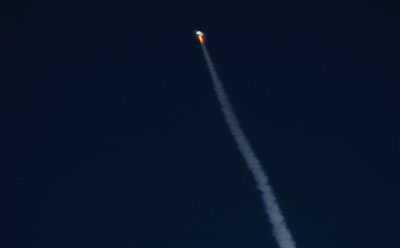Scaled Composites’ SpaceShipOne: stunt plane or new road to the stars?by Taylor Dinerman
|
| It was suitably symbolic that someone who made his money in our current information age should have financed this new step. |
Rumor has it that Paul Allen has given Burt Rutan $26 million to build the Scaled Composites entry. To spend $26 million to win a $10 million dollar prize is no one’s idea of a smart transaction. In fact, the X Prize, and the teams that are competing for it, plan to develop a whole new suborbital industry. Space tourism, remote sensing, and component testing will be some of the services provided by this new class of vehicle. Later versions could provide extremely rapid point-to-point movement of packages and people.
Curiously, this industry will be developing vehicles that the Pentagon has been thinking about, such as RASCAL, FALCON, or some of the National Aerospace Initiative type craft, and doing so without a dime from the Defense or NASA budgets. The hostility of some of the people on the X Prize teams to dealing with the federal government is the natural result of creative small business types rubbing up against the mother of all bureaucracies.
Will the suborbital PRSR industry actually amount to anything, or will is just be a small niche player like the model rocket industry? Beyond the X Prize, can the entrepreneurs sustain their businesses long enough to transform themselves into substantial players in the US aerospace industry which, God knows, desperately needs new corporate blood? Above all, can any of these vehicles be transformed, through a step-by-step process, into a true orbital vehicle? When SpaceShipOne broke the sound barrier, someone said, “one Mach down, twenty four to go.”
Already, SpaceShipOne has proven that the hybrid rocket engines built by SpaceDev can actually be successfully integrated into a rocket plane. This may be a one-off technical dead end or it may be a major breakthrough. On a small scale, the X Prize is leading to new technologies and new ways of doing business that were previously unimaginable. In fact, the spinoff from the X Prize may end up being richer on a dollar-for-dollar basis than the new products and techniques emerging from normal space and defense spending. Unlike large corporations, these small operators are always looking for new and original ways to leverage their investments.
| When SpaceShipOne broke the sound barrier, someone said, “one Mach down, twenty four to go.” |
This industry that, for want of a better term, should be called the RLV industry (since, in the end, that is what they are developing) has been unsuccessfully reaching for the stars for years. The X Prize has given them a focus and an interim goal. It is a miracle of human imagination that so many people have held on to the dream and have been willing to endure the hardships for so long.
The ultimate payoff is still uncertain and perhaps unobtainable but, if they manage to produce an economically viable RLV, the true Space Age will begin. This is a very high-stakes gamble. The winner of the X Prize will have taken a large step towards the goal, but it will be only one step. Whoever wins, Burt Rutan and Scaled Composites have earned their place in that Valhalla in which all truly creative aerospace engineers end up. The Wright Brothers will be there to greet him.
